BMW X5 4.8IS 2006 E53 Service Manual
Manufacturer: BMW, Model Year: 2006, Model line: X5 4.8IS, Model: BMW X5 4.8IS 2006 E53Pages: 202, PDF Size: 4.13 MB
Page 41 of 202
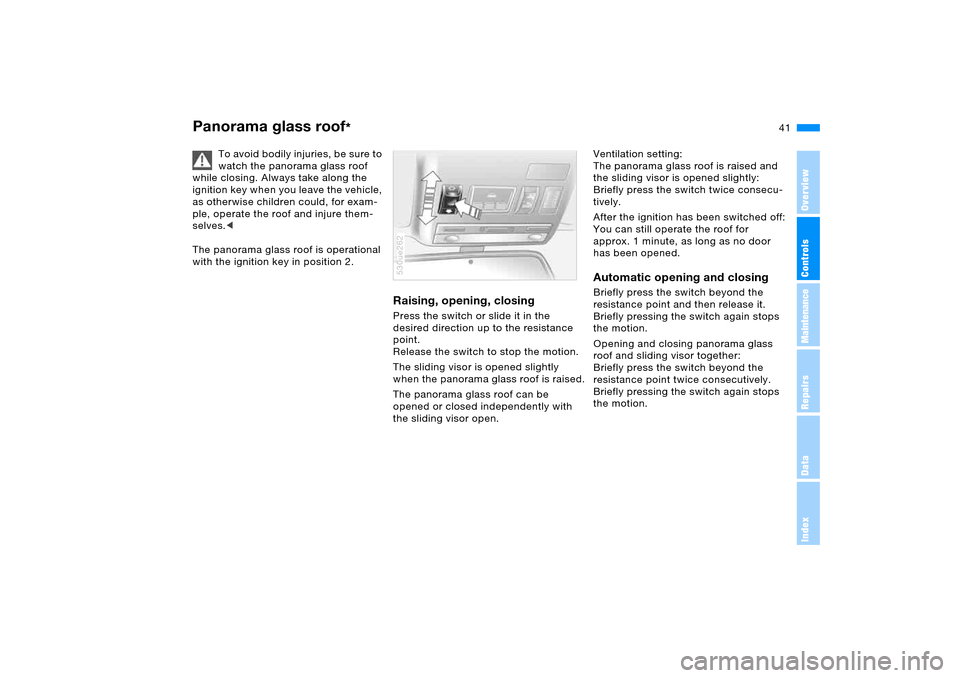
41n
OverviewControlsMaintenanceRepairsDataIndex
Panorama glass roof
*
To avoid bodily injuries, be sure to
watch the panorama glass roof
while closing. Always take along the
ignition key when you leave the vehicle,
as otherwise children could, for exam-
ple, operate the roof and injure them-
selves.<
The panorama glass roof is operational
with the ignition key in position 2.
Raising, opening, closingPress the switch or slide it in the
desired direction up to the resistance
point.
Release the switch to stop the motion.
The sliding visor is opened slightly
when the panorama glass roof is raised.
The panorama glass roof can be
opened or closed independently with
the sliding visor open.530ue262
Ventilation setting:
The panorama glass roof is raised and
the sliding visor is opened slightly:
Briefly press the switch twice consecu-
tively.
After the ignition has been switched off:
You can still operate the roof for
approx. 1 minute, as long as no door
has been opened.Automatic opening and closing Briefly press the switch beyond the
resistance point and then release it.
Briefly pressing the switch again stops
the motion.
Opening and closing panorama glass
roof and sliding visor together:
Briefly press the switch beyond the
resistance point twice consecutively.
Briefly pressing the switch again stops
the motion.
Page 42 of 202
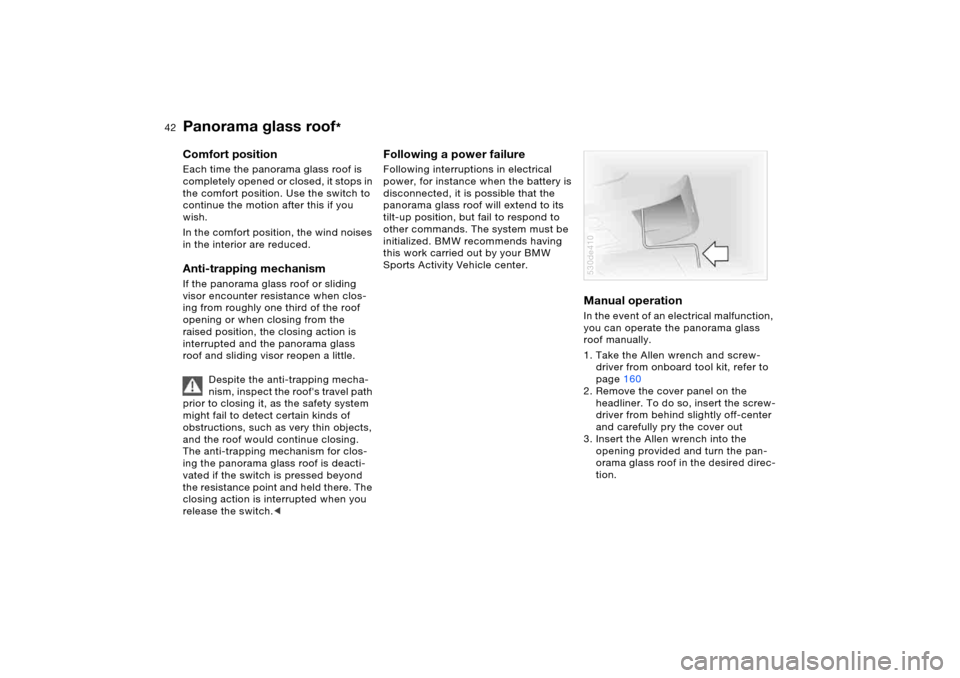
42n
Panorama glass roof
*
Comfort position Each time the panorama glass roof is
completely opened or closed, it stops in
the comfort position. Use the switch to
continue the motion after this if you
wish.
In the comfort position, the wind noises
in the interior are reduced.Anti-trapping mechanism If the panorama glass roof or sliding
visor encounter resistance when clos-
ing from roughly one third of the roof
opening or when closing from the
raised position, the closing action is
interrupted and the panorama glass
roof and sliding visor reopen a little.
Despite the anti-trapping mecha-
nism, inspect the roof's travel path
prior to closing it, as the safety system
might fail to detect certain kinds of
obstructions, such as very thin objects,
and the roof would continue closing.
The anti-trapping mechanism for clos-
ing the panorama glass roof is deacti-
vated if the switch is pressed beyond
the resistance point and held there. The
closing action is interrupted when you
release the switch.<
Following a power failure Following interruptions in electrical
power, for instance when the battery is
disconnected, it is possible that the
panorama glass roof will extend to its
tilt-up position, but fail to respond to
other commands. The system must be
initialized. BMW recommends having
this work carried out by your BMW
Sports Activity Vehicle center.
Manual operation In the event of an electrical malfunction,
you can operate the panorama glass
roof manually.
1. Take the Allen wrench and screw-
driver from onboard tool kit, refer to
page160
2. Remove the cover panel on the
headliner. To do so, insert the screw-
driver from behind slightly off-center
and carefully pry the cover out
3. Insert the Allen wrench into the
opening provided and turn the pan-
orama glass roof in the desired direc-
tion.530de410
Page 43 of 202
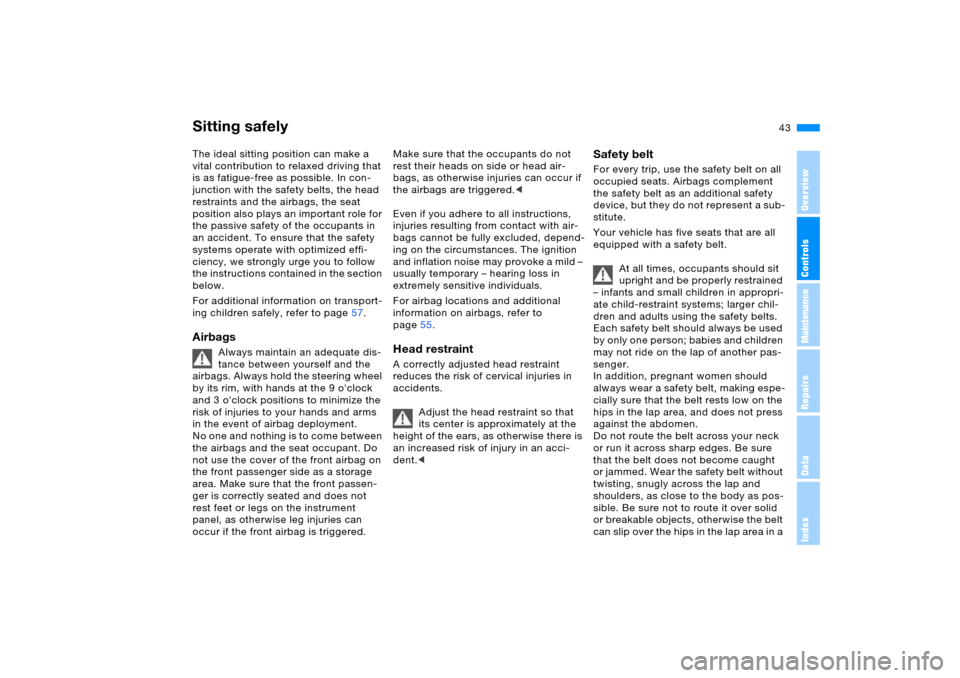
43n
OverviewControlsMaintenanceRepairsDataIndex
The ideal sitting position can make a
vital contribution to relaxed driving that
is as fatigue-free as possible. In con-
junction with the safety belts, the head
restraints and the airbags, the seat
position also plays an important role for
the passive safety of the occupants in
an accident. To ensure that the safety
systems operate with optimized effi-
ciency, we strongly urge you to follow
the instructions contained in the section
below.
For additional information on transport-
ing children safely, refer to page57.Airbags
Always maintain an adequate dis-
tance between yourself and the
airbags. Always hold the steering wheel
by its rim, with hands at the 9 o'clock
and 3 o'clock positions to minimize the
risk of injuries to your hands and arms
in the event of airbag deployment.
No one and nothing is to come between
the airbags and the seat occupant. Do
not use the cover of the front airbag on
the front passenger side as a storage
area. Make sure that the front passen-
ger is correctly seated and does not
rest feet or legs on the instrument
panel, as otherwise leg injuries can
occur if the front airbag is triggered.
Make sure that the occupants do not
rest their heads on side or head air-
bags, as otherwise injuries can occur if
the airbags are triggered.<
Even if you adhere to all instructions,
injuries resulting from contact with air-
bags cannot be fully excluded, depend-
ing on the circumstances. The ignition
and inflation noise may provoke a mild –
usually temporary – hearing loss in
extremely sensitive individuals.
For airbag locations and additional
information on airbags, refer to
page55.Head restraint A correctly adjusted head restraint
reduces the risk of cervical injuries in
accidents.
Adjust the head restraint so that
its center is approximately at the
height of the ears, as otherwise there is
an increased risk of injury in an acci-
dent.<
Safety belt For every trip, use the safety belt on all
occupied seats. Airbags complement
the safety belt as an additional safety
device, but they do not represent a sub-
stitute.
Your vehicle has five seats that are all
equipped with a safety belt.
At all times, occupants should sit
upright and be properly restrained
– infants and small children in appropri-
ate child-restraint systems; larger chil-
dren and adults using the safety belts.
Each safety belt should always be used
by only one person; babies and children
may not ride on the lap of another pas-
senger.
In addition, pregnant women should
always wear a safety belt, making espe-
cially sure that the belt rests low on the
hips in the lap area, and does not press
against the abdomen.
Do not route the belt across your neck
or run it across sharp edges. Be sure
that the belt does not become caught
or jammed. Wear the safety belt without
twisting, snugly across the lap and
shoulders, as close to the body as pos-
sible. Be sure not to route it over solid
or breakable objects, otherwise the belt
can slip over the hips in the lap area in a
Sitting safely
Page 44 of 202
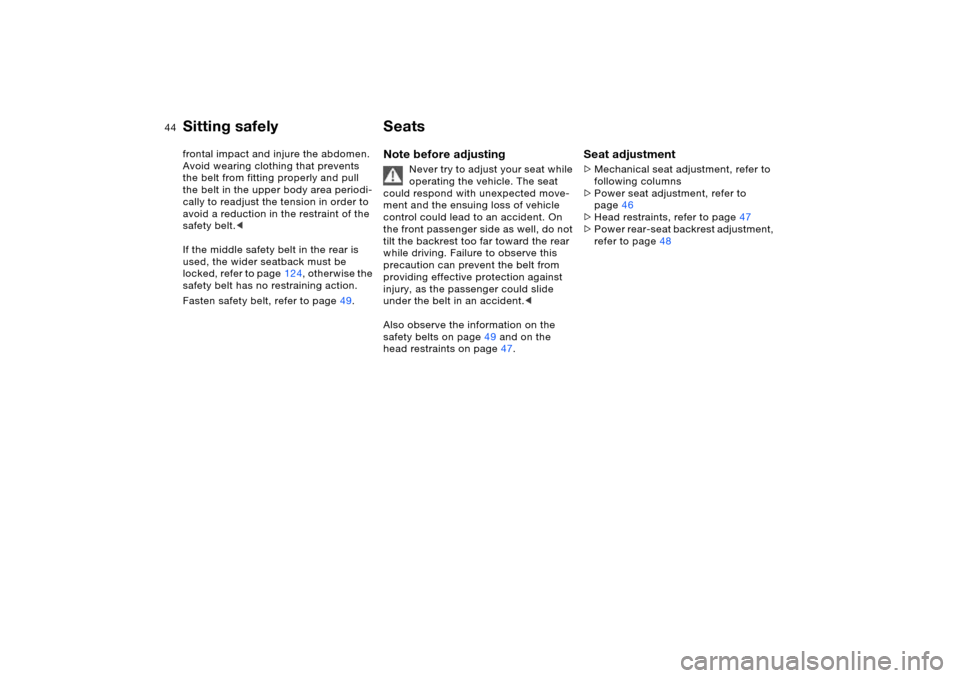
44n
Sitting safely Seatsfrontal impact and injure the abdomen.
Avoid wearing clothing that prevents
the belt from fitting properly and pull
the belt in the upper body area periodi-
cally to readjust the tension in order to
avoid a reduction in the restraint of the
safety belt.<
If the middle safety belt in the rear is
used, the wider seatback must be
locked, refer to page124, otherwise the
safety belt has no restraining action.
Fasten safety belt, refer to page49.
Note before adjusting
Never try to adjust your seat while
operating the vehicle. The seat
could respond with unexpected move-
ment and the ensuing loss of vehicle
control could lead to an accident. On
the front passenger side as well, do not
tilt the backrest too far toward the rear
while driving. Failure to observe this
precaution can prevent the belt from
providing effective protection against
injury, as the passenger could slide
under the belt in an accident.<
Also observe the information on the
safety belts on page49 and on the
head restraints on page47.
Seat adjustment>Mechanical seat adjustment, refer to
following columns
>Power seat adjustment, refer to
page46
>Head restraints, refer to page47
>Power rear-seat backrest adjustment,
refer to page48
Page 45 of 202
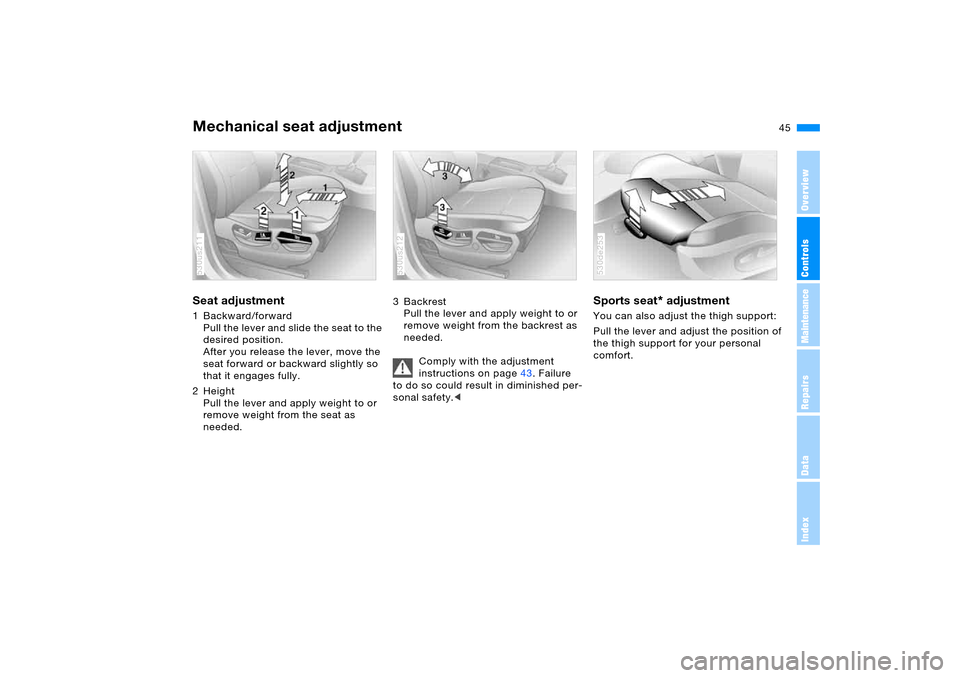
45n
OverviewControlsMaintenanceRepairsDataIndex
Mechanical seat adjustment Seat adjustment 1 Backward/forward
Pull the lever and slide the seat to the
desired position.
After you release the lever, move the
seat forward or backward slightly so
that it engages fully.
2Height
Pull the lever and apply weight to or
remove weight from the seat as
needed. 530us211
3Backrest
Pull the lever and apply weight to or
remove weight from the backrest as
needed.
Comply with the adjustment
instructions on page43. Failure
to do so could result in diminished per-
sonal safety.< 530us212
Sports seat
* adjustment
You can also adjust the thigh support:
Pull the lever and adjust the position of
the thigh support for your personal
comfort. 530de253
Page 46 of 202
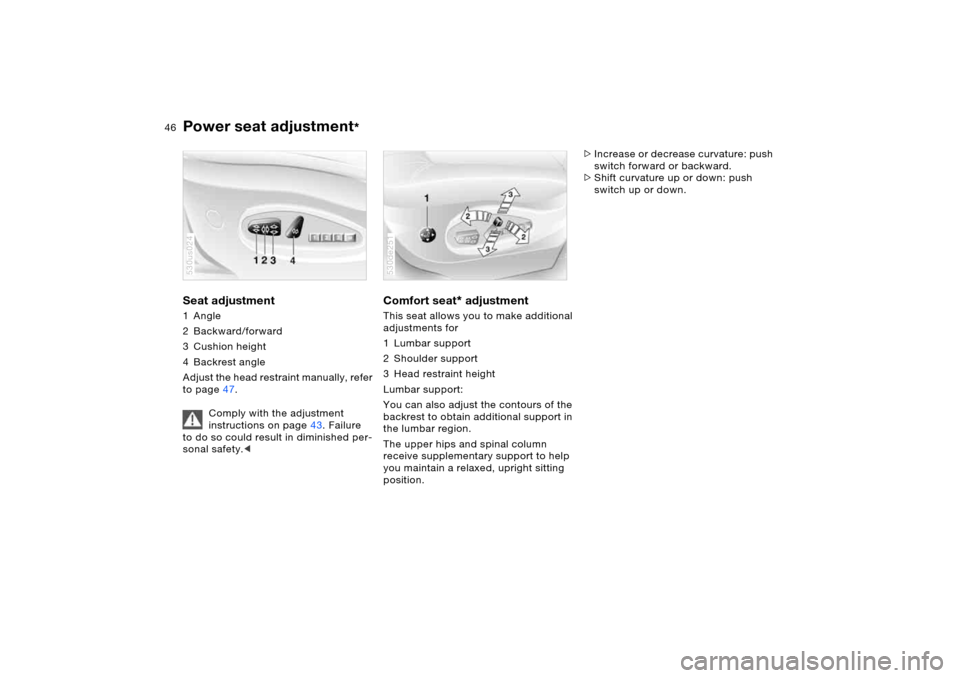
46n
Power seat adjustment
*
Seat adjustment 1Angle
2 Backward/forward
3 Cushion height
4 Backrest angle
Adjust the head restraint manually, refer
to page47.
Comply with the adjustment
instructions on page43. Failure
to do so could result in diminished per-
sonal safety.< 530us024
Comfort seat
* adjustment
This seat allows you to make additional
adjustments for
1Lumbar support
2 Shoulder support
3 Head restraint height
Lumbar support:
You can also adjust the contours of the
backrest to obtain additional support in
the lumbar region.
The upper hips and spinal column
receive supplementary support to help
you maintain a relaxed, upright sitting
position.530de251
>Increase or decrease curvature: push
switch forward or backward.
>Shift curvature up or down: push
switch up or down.
Page 47 of 202
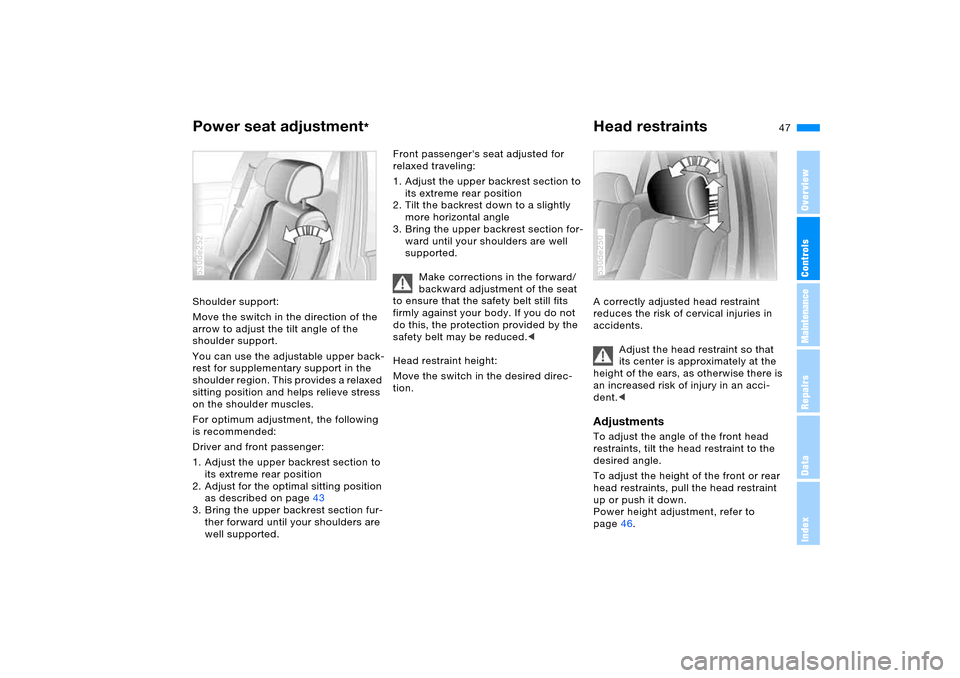
47n
OverviewControlsMaintenanceRepairsDataIndex
Power seat adjustment
*
Head restraints
Shoulder support:
Move the switch in the direction of the
arrow to adjust the tilt angle of the
shoulder support.
You can use the adjustable upper back-
rest for supplementary support in the
shoulder region. This provides a relaxed
sitting position and helps relieve stress
on the shoulder muscles.
For optimum adjustment, the following
is recommended:
Driver and front passenger:
1. Adjust the upper backrest section to
its extreme rear position
2. Adjust for the optimal sitting position
as described on page43
3. Bring the upper backrest section fur-
ther forward until your shoulders are
well supported.530de252
Front passenger's seat adjusted for
relaxed traveling:
1. Adjust the upper backrest section to
its extreme rear position
2. Tilt the backrest down to a slightly
more horizontal angle
3. Bring the upper backrest section for-
ward until your shoulders are well
supported.
Make corrections in the forward/
backward adjustment of the seat
to ensure that the safety belt still fits
firmly against your body. If you do not
do this, the protection provided by the
safety belt may be reduced.<
Head restraint height:
Move the switch in the desired direc-
tion.
A correctly adjusted head restraint
reduces the risk of cervical injuries in
accidents.
Adjust the head restraint so that
its center is approximately at the
height of the ears, as otherwise there is
an increased risk of injury in an acci-
dent.
desired angle.
To adjust the height of the front or rear
head restraints, pull the head restraint
up or push it down.
Power height adjustment, refer to
page46.530de250
Page 48 of 202
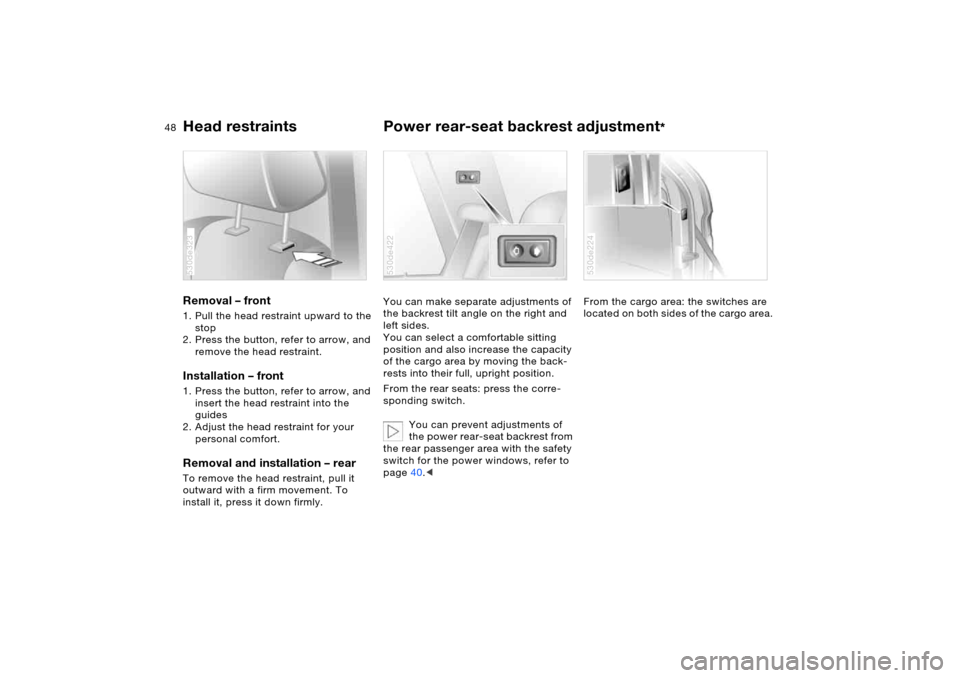
48n
Head restraints Power rear-seat backrest adjustment
*
Removal – front 1. Pull the head restraint upward to the
stop
2. Press the button, refer to arrow, and
remove the head restraint.Installation – front 1. Press the button, refer to arrow, and
insert the head restraint into the
guides
2. Adjust the head restraint for your
personal comfort.Removal and installation – rearTo remove the head restraint, pull it
outward with a firm movement. To
install it, press it down firmly. 530de323
You can make separate adjustments of
the backrest tilt angle on the right and
left sides.
You can select a comfortable sitting
position and also increase the capacity
of the cargo area by moving the back-
rests into their full, upright position.
From the rear seats: press the corre-
sponding switch.
You can prevent adjustments of
the power rear-seat backrest from
the rear passenger area with the safety
switch for the power windows, refer to
page40.< 530de422
From the cargo area: the switches are
located on both sides of the cargo area. 530de224
Page 49 of 202
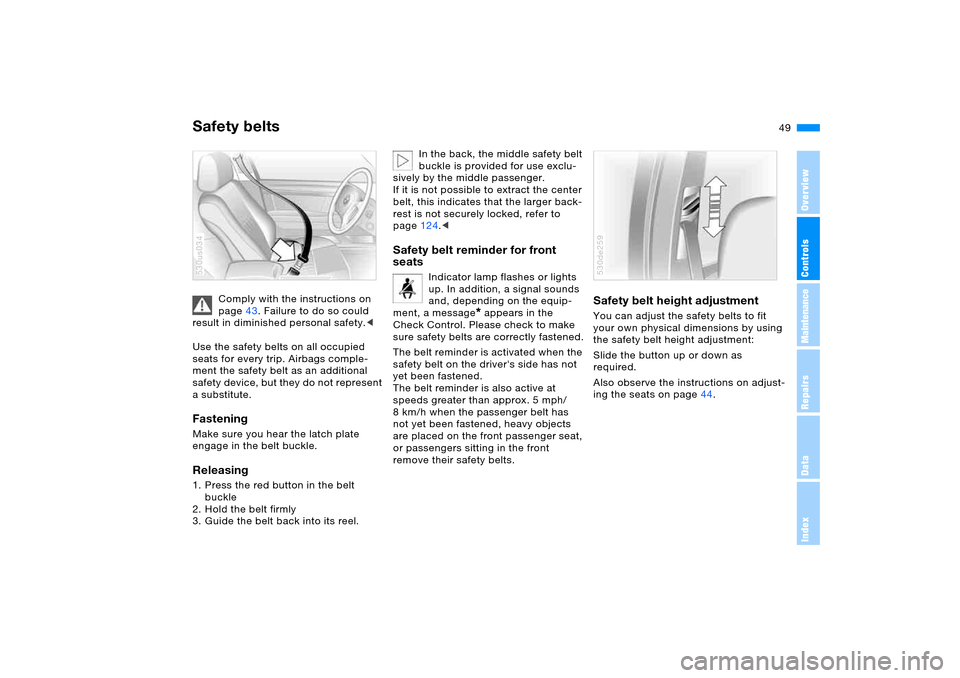
49n
OverviewControlsMaintenanceRepairsDataIndex
Safety belts
Comply with the instructions on
page43. Failure to do so could
result in diminished personal safety.<
Use the safety belts on all occupied
seats for every trip. Airbags comple-
ment the safety belt as an additional
safety device, but they do not represent
a substitute.
Fastening Make sure you hear the latch plate
engage in the belt buckle.Releasing1. Press the red button in the belt
buckle
2. Hold the belt firmly
3. Guide the belt back into its reel.530us034
In the back, the middle safety belt
buckle is provided for use exclu-
sively by the middle passenger.
If it is not possible to extract the center
belt, this indicates that the larger back-
rest is not securely locked, refer to
page124.<
Safety belt reminder for front
seats
Indicator lamp flashes or lights
up. In addition, a signal sounds
and, depending on the equip-
ment, a message
* appears in the
Check Control. Please check to make
sure safety belts are correctly fastened.
The belt reminder is activated when the
safety belt on the driver's side has not
yet been fastened.
The belt reminder is also active at
speeds greater than approx. 5 mph/
8 km/h when the passenger belt has
not yet been fastened, heavy objects
are placed on the front passenger seat,
or passengers sitting in the front
remove their safety belts.
Safety belt height adjustment You can adjust the safety belts to fit
your own physical dimensions by using
the safety belt height adjustment:
Slide the button up or down as
required.
Also observe the instructions on adjust-
ing the seats on page44.530de259
Page 50 of 202
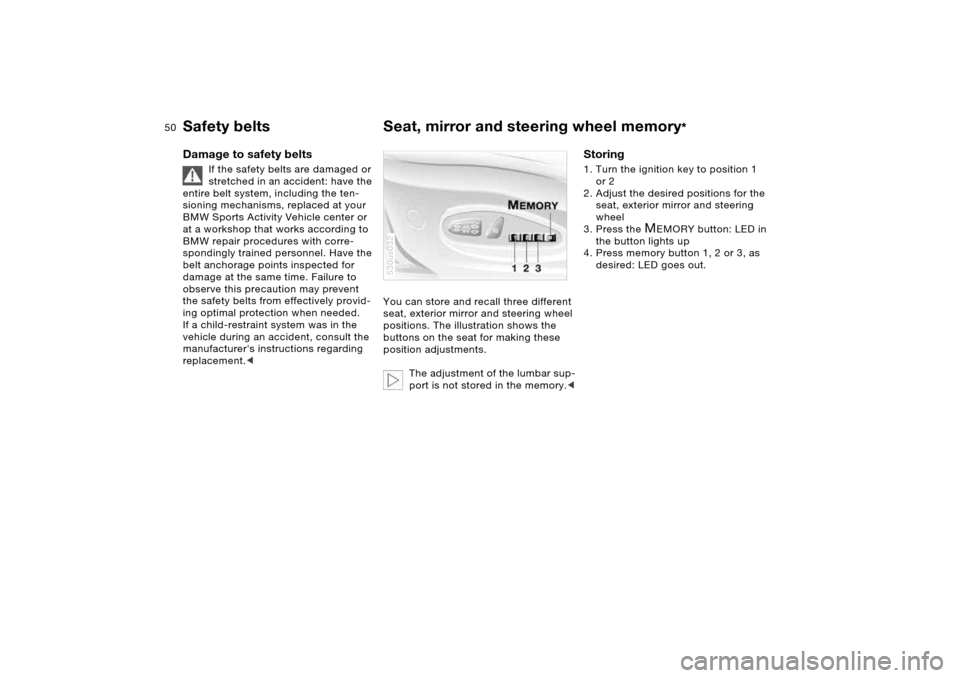
50n
Safety belts Seat, mirror and steering wheel memory
*
Damage to safety belts
If the safety belts are damaged or
stretched in an accident: have the
entire belt system, including the ten-
sioning mechanisms, replaced at your
BMW Sports Activity Vehicle center or
at a workshop that works according to
BMW repair procedures with corre-
spondingly trained personnel. Have the
belt anchorage points inspected for
damage at the same time. Failure to
observe this precaution may prevent
the safety belts from effectively provid-
ing optimal protection when needed.
If a child-restraint system was in the
vehicle during an accident, consult the
manufacturer's instructions regarding
replacement.<
You can store and recall three different
seat, exterior mirror and steering wheel
positions. The illustration shows the
buttons on the seat for making these
position adjustments.
The adjustment of the lumbar sup-
port is not stored in the memory.<530us032
Storing 1. Turn the ignition key to position 1
or 2
2. Adjust the desired positions for the
seat, exterior mirror and steering
wheel
3. Press the
M
EMORY button: LED in
the button lights up
4. Press memory button 1, 2 or 3, as
desired: LED goes out.